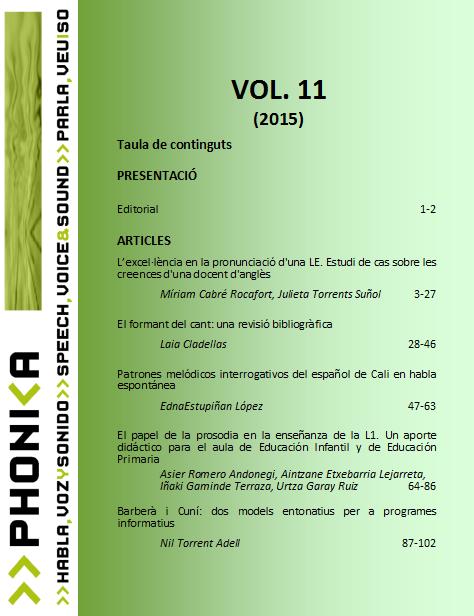El formato del canto: Una revisión bibliográfica
DOI:
https://doi.org/10.1344/phonica.2015.11.28-46Palabras clave:
Voz cantada, Formante del canto, Calidad de la voz, AcústicaResumen
El canto es el uso de la voz como un instrumento musical. La caracterización de la voz lírica cantada es muchas veces ambigua y abstracta, pero hay un consenso general en el hecho de que somos capaces de diferenciar una voz lírica de otras voces cantadas. Uno de los parámetros acústicos diferenciales de las voces líricas es el llamado “formante del canto”. Diversos investigadores han llevado a cabo estudios para corroborar o no la presencia del formante del canto en las voces líricas. Este artículo ofrece una revisión de conjunto.
Citas
Abad Royo, JM.; Abad Marco, A.; Tísner Giraldo, B.; Pérez Sámchez, A. & Chamizo García, JJ. (2003) Trabajo de investigación y clínica aplicada. “Análisis digital de la voz. Conceptos básicos”. O. R. L. Aragón 2003’; 6 (2) 13-19.
Bartholomew, W. T. (1934): “A physical definition of good “voice quality” in the male voice,” J. Acoust. Soc. Am., 1, 24-33.
Bloothooft, G. & R. Plomp (1984): “Spectral analysis of sung vowels. I. Variation due to differences between vowels, singers and models of singing”, Journal of Acoustical Society of America, 75 (4).
Bloothooft, G. & R. Plomp (1985): “Spectral analysis of sung vowels. II. The effect of fundamental frequency on vowel spectra”, Journal of Acoustical Society of America, 77 (4).
Bloothooft, G. & R. Plomp (1986): “Spectral analysis of sung vowels. III. Characteristics of singers and models of singing”, Journal of Acoustical Society of America, 79 (3).Bretos, J & Sundberg, J. (2003): “Measurements of Vibrato Parameters in Long Sustained Crescendo Notes as Sung by Ten Sopranos”. Journal of Voice, Vol. 17, No. 3, pp. 343-352.
Cantero Serena, F. J. (2003): “Fonética y didàctica de la pronunciación”, en Mendoza, A. (coord): Didáctica de la lengua y la literatura. Madrid: Prentice Hall.Cantero Serena, F. J. (2004): “Comunicació i veu”, a Articles de didàctica de la llengua i la literatura, num. 32. (Monografia: veu i locució).
Detweiler, RF. (1994). An investigation of the laryngeal system as the resonance source of the singer’s formant. Journal of Voice, 8(4), 303-313.
Elgström, E. (2006): “Fonetometria: una proposta de protocol”, Phonica, vol. 2.
Fant, G. (1960): Acoustic Theory of Speech Production. The Hague: Mouton.García-Tapia, R. & Cobeta, I (1996): Diagnóstico y tratamiento de los trastornos de la voz. Editorial Garsi, S.A. Madrid.
González, J.; Cervera, T. & J.L. Miralles (202): “Análisis acústico de la voz: fiabilidad de un conjunto de parámetros multidimensionales”, Acta Otorrinolaringológica, 53 (256-268).
Hines, J. (1990). Great singers on great singing. New York: 5th Limelight Edition.
Hirano, M. (1981): Clinical Examination of Voice. Springer-Verlag Wien. New York.
Kenny, D. T. & Mitchell, H. F. (2006): “Acoustic and Perceptual Appraisal of Vocal Gestures in the Female Classical Voice”. Journal of Voice, Vol. 20, No. 1, pp. 55-70.Laver, J. (1980): The phonetic description of voice quality. Cambridge University Press. Great Britain.
Lindqvist, J. (1970): "The voice source studied by means of inverse
filtering", STL-QPSR 1/1970
Omori, K; Kojima, H.; Kakani, R.; Slavit, DH. & Blaugrun, SM. (1997): “Acoustic characteristics of rough voice: Subharmonics.” Journal of Voice, 11: 40-47
Rontal, E.; Rontal, M. & Rolnick, M. I (1975): “Objective Evaluation of vocal pathology using voice spectrography”. Annals of Otology, Rhinology and Laryngology. 84.
Sengupta, R. (1990). “Study on some aspects of the “Singer’s Formant” in north Indian classical singing”. Journal of Voice, 4 (2), 129-134.
Sundberg, J. (1970). “Formant structure and articulation of spoken and sung vowels”. Folia Phoniatr., 22, 28-48.
Sundberg, J. (1972): “Articulatory interpretation of the ‘singer’s formant’ ”. J Acoust Soc Am., 55, 834-844.
Sundberg, J. (1973). “The source spectrum in professional singing”. Folia Phoniatr., 25, 71-90.
Sundberg, J. (1977). “The acoustics of singing voice”. Scientific American, 236 (3), 82-84, 86, 88-91.
Sundberg, J. (1987): The science of the singing voice. Northern Illinois University Press. Dekalb, Illinois.
Sundberg, J. (2001): “Level and Center Frequency of the Singer’s Formant”. Journal of Voice, Vol15. No. 2, pp. 176-186.
Titze, I.R. & Story B. H. (1997). “Acoustic interactions of the voice source with the lower vocal tract”. J Acoust Soc Am., 101(4), 2234-2243.
Vennard, W. (1967). Singing: the Mechanism and the Technique. New York: Carl Fischer Inc.
Wang, S. (1985). “Singing voice: Bright timbre, singer’s formants and larynx positions”. SMAC83 Conference Proceedings, Stockholm, 1, 31-322.
Weiss, R., Brown, W.S Jr. & Morris, J (2001): “Singer’s Formant in Sopranos: Fact or Fiction?” Journal of Voice, Vol. 15, No. 4, pp. 457-468.
Descargas
Publicado
Número
Sección
Licencia
El autor/a que publica en esta revista está de acuerdo con los siguientes términos:
a. El autor/a conserva los derechos de autoría y otorga a la revista el derecho de primera publicación de la obra.
b. Todos los contenidos incluidos en PHONICA están sujetos a la licencia de Reconocimiento 4.0 Internacional de Creative Commons, que permite compartir la obra con terceros, siempre que se reconozca la autoría, la publicación inicial en esta revista y las condiciones de la licencia.



